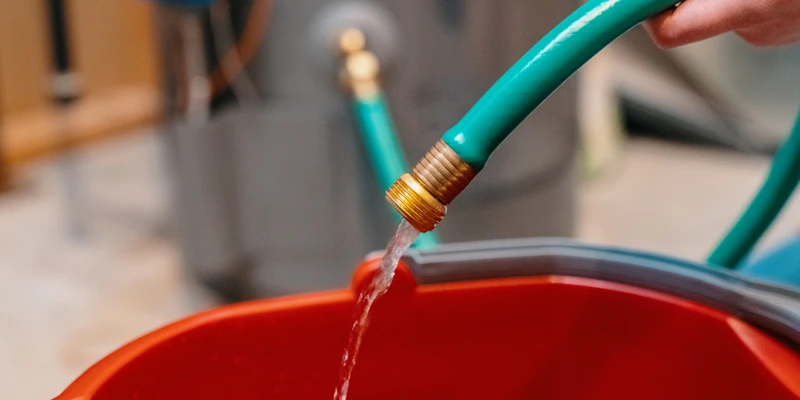
Even if they know how to drain a water heater, many homeowners neglect this essential maintenance task. Over time, sediment, or minerals such as calcium and magnesium, settles in the bottom of your water heater. Regularly draining a water heater clears the sediment, resulting in optimal energy efficiency, performance, and longevity.
The Importance of Draining a Water Heater
As sediment and minerals build up in your water heater, you might experience higher utility costs, hot water shortages, clogs in your water fixtures, or a complete breakdown of your water heater. Draining a water heater removes much of the sediment that can lead to a multitude of problems, including a permanently damaged appliance.
Water heater draining benefits include:
Energy Efficiency
Removing sediment ensures your water heater doesn't have to work any harder than it should, reducing energy consumption and lowering energy costs.
Extended Lifespan
Regular maintenance, like sediment removal, can help extend the lifespan of a water heater and help maintain the manufacturer's warranty.
Safe Operation
When you drain the sediment from a water heater, it prevents debris from damaging important safety components like the pressure relief valve.
Cost Savings
Annual servicing, including sediment removal, can help minimize potentially costly water heater repairs and prevent damage to water pipes and fixtures.
How Often Should You Drain a Water Heater?
To ensure your water heater operates optimally, always defer to the manufacturer's maintenance recommendations. A typical water heater should be drained at least once a year to prevent sediment buildup. If your water supply contains excessive minerals and other deposits, a semi-annual schedule may be necessary. You may also need to drain the tank when you notice rusty or lukewarm water.
Step-by-Step Guide to Draining Your Water Heater
Draining your water heater does not have to be a complicated or time-consuming task. Grab a hose or two, put on heat-resistant gloves, and follow this guide on how to drain a water heater:
- Close the cold water supply valve on the water heater and disconnect it from the power source. If you have an electric water heater, turn off the circuit breaker at the main breaker panel. If your water heater is gas-powered, turn the control knob to the pilot position.
- Turn the hot water on full blast at a nearby faucet and let it run to prevent a vacuum from forming in the water lines, allowing the water heater to drain more easily.
- Attach a garden hose to the opening of the drain valve and run it to a basement floor drain, somewhere outside, or an empty bucket. If your water heater is below ground level, you’ll need a portable pump and two hoses—one from the water heater to the pump and one from the pump to the discharge area.
- With your gloves on, slowly open the drain valve, allowing water and sediment to flow out of the water heater and into the hose. If water doesn’t flow out right away, you may need to loosen the valve with a screwdriver. Let the water run at full force for about ten minutes.
- When emptying the contents of a water heater into a drain, use a colander to catch the sediment. If you’re using a bucket, make sure you empty it as needed to prevent overflowing. Once you’ve finished draining all the water, briefly turn on the cold water supply to the tank to stir up any remaining sediment. Repeat the process until the water runs clear.
- Once the water from the tank runs clear, close the water heater drain valve and remove the hose. Turn the cold water supply on to refill the tank. Run hot water in a nearby sink until the water turns cold. Turn the gas valve on or cut the breaker on. Once you’ve closed the drain valve, check the drain valve opening for water leaks. If there are leaks, it’s time to call in the water heater professionals at Aire Serv® for backup.
Signs Your Water Heater Needs Draining
Flushing a water heater every six months to a year should keep minerals and other deposits from building up. However, most of the components in a water heater, including the tank, are hidden, so it's essential to know the signs your water heater needs draining right away.
Less Hot Water
Sediment buildup can cause water temperatures to fluctuate between hot and warm or not hot at all. Draining the tank is often the most practical and easiest solution.
Unusual Noises
Unusual noises inside your water heater can be caused by mineral particles hitting the inside of the tank because of sediment buildup.
Rust-Colored Water
If your hot water has a rust-colored tint, the likely problem is sediment buildup or an anode rod in need of replacement.
Decreased Water Pressure
When sediment builds up too much, debris and hard water particles can narrow the inside of the pipes, causing clogs.
Should You DIY or Hire a Professional?
When learning how to drain a water heater, it's critical to know that not every hot water heater is as simple as it may appear. Trained professionals know how to drain a water heater without causing damage or a mess. Even when you know how to empty a water heater, there are numerous reasons hiring a professional is preferred. An experienced service professional can identify the types of sediment and understand how it can affect the appliance. Professionals use specialized hoses to drain the tank correctly. Plus, the pros can inspect your water heater for potential issues while they're draining the appliance.
Maintaining Your Water Heater After Draining
A water heater can last for decades with adequate maintenance and timely repairs. Draining the tank is a critical maintenance task, and delegating it to professionals ensures it's done right. However, there are a few maintenance tasks homeowners can tackle to help a water heater be more efficient and last longer.
- Inspect the pressure relief valve for corrosion or leaks.
- Check for leaks from water pipes.
- Insulate the water heater to prevent heat loss and increase efficiency.
- Maintain a water heater temperature of 120 to 130 degrees Fahrenheit.
- Maintain adequate ventilation around the water heater with 4 to 6 inches of clearance.
Keep Your Water Heater Running Efficiently
Regular maintenance can help your water heater work more efficiently and extend its longevity significantly. Draining a water heater to remove sediment helps minimize corrosion, leaks, and damage to heating elements and other components. Keep an eye out for the most common signs of sediment buildup, and reach out to a professional to ensure your water heater gets the care it deserves. It's also recommended that routine in-house maintenance be performed every few months to keep the hot water flowing.
The licensed professionals at Aire Serv are experts at draining a water heater. You can also count on us for other repairs and replacement of residential and commercial water heaters. Whatever its type, brand, or age, your local Aire Serv can help you determine whether your aging water heater needs repair or is a suitable candidate for replacement. Call Aire Serv today or schedule a free estimate online.
This article is intended for general guidance only and may not be applicable to every situation. You are responsible for determining the proper course of action for your property and your situation. Aire Serv is not responsible for any damages that occur as a result of any advice or guidance derived from blog content. For the most accurate guidance, contact an independently owned and operated Aire Serv for more information and a professional on-site assessment.

